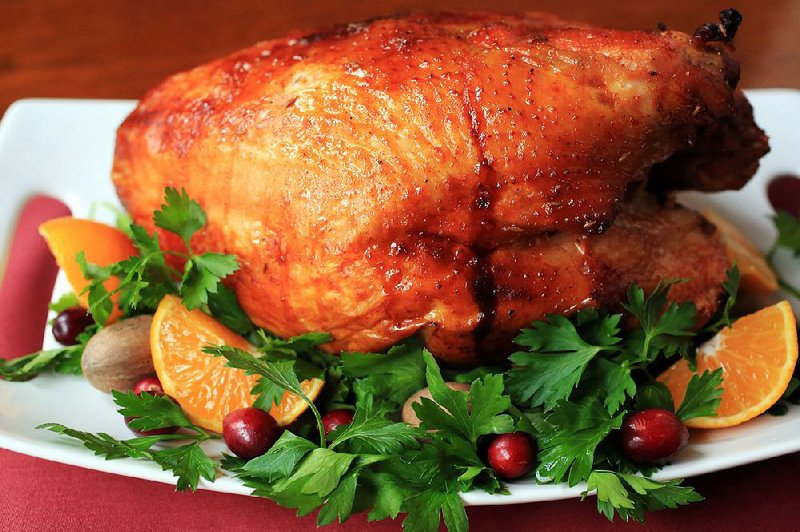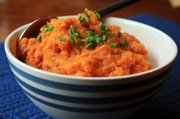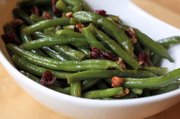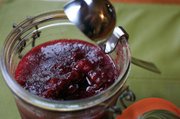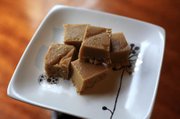What's maple got to do with Thanksgiving?
The sugar maple tree that gives us maple syrup is native only to North America, making it America's original sweetener.
The use of maple syrup in American cooking dates to Colonial times, as the American Indians taught the early settlers how to tap the trees for their sweet nectar. Some food historians believe the Indians also taught the settlers how to turn the boiled sap into solid sugar, but others think it was French explorers and missionaries who taught the Indians. However, according to the University of Vermont History of Maple website, by the 1700s native peoples and settlers were using iron and copper kettles to turn the sap into syrup and sugar.
The Indians frequently made the syrup into a refreshing beverage, poured it over snow to make a frozen confection and used it as a seasoning, much like salt and pepper for preparing meats and vegetables, according to foodtimeline.org.
The University of Vermont's Maple Research website notes, "Maple sugar was promoted by the Quakers and abolitionists as an alternative to West Indian 'slave-produced' cane sugar."
Until the 1880s maple sugar was less expensive than cane sugar, making it a popular choice.
According to the Arbor Day Foundation, the trees will grow as far south as Plant Hardiness Zone 8, which includes the southern half of Arkansas and much of Louisiana. But syrup harvesting requires very specific conditions -- freezing temperatures at night and in the 40s during the day -- that are found primarily in the Great Lakes region and northern East Coast of the United States as well as the Canadian provinces of Quebec, New Brunswick and Nova Scotia.
Until fairly recently the maple syrup lining retail shelves was labeled Grade A and Grade B. Grade A was lighter in color with a delicate flavor, while Grade B was dark amber with robust maple flavor.
The grading system was not an indication of quality, but a way to "differentiate between natural variations in color and flavor," writes Katie Webster in her book, Maple: 100 Sweet and Savory Recipes Featuring Pure Maple Syrup.
In 2014 maple producers in the United States and Canada adopted a new voluntary grading system; the United States Department of Agriculture made the new system official early this year.
Under the new system, all maple syrup sold to the general public is Grade A. Grade A syrup includes four color and flavor classes: U.S. Grade A Golden (delicate color and taste); U.S. Grade A Amber (rich color and taste); U.S. Grade A Dark (dark color and robust taste); and U.S. Grade A Very Dark (very dark color and robust taste).
There is also Processing Grade, which is most often used in food manufacturing to give food such as meats, cereals and granola a maple flavor.
The color and flavor variations of maple syrup are attributed to the season. Early-season syrup tends to be lightest in color and flavor. The later in the season the syrup is drawn, the darker its color and more robust its flavor.
Higher temperatures and "microbial action" later in the season result in the darker color, Webster writes.
While maple syrup is still a sugar with all of the effects of overindulgence associated with other sugars, it does retain higher traces of minerals (most notably calcium, iron and potassium) than granulated white sugar.
We're not suggesting maple-izing the entire Thanksgiving menu -- though you certainly could with the following recipes -- but the versatile, flavorful sweetener goes well with a variety of traditional Thanksgiving menu items.
Maple Spiced Pecans
1/4 cup dark maple syrup
2 teaspoons butter
1 teaspoons apple pie spice (see note)
1/2 teaspoon coarse salt
2 cups pecan halves
Heat oven to 350 degrees. Line a rimmed baking sheet with parchment paper or a nonstick baking mat.
In a microwave-safe bowl, combine the maple syrup and butter. Microwave 15 seconds; stir to melt butter. Stir in pie spice and salt until well combined. Add nuts and stir to coat.
Arrange nuts in a single layer on the prepared baking sheet. Bake 8 to 10 minutes or until maple mixture is bubbly; stir well and bake 4 to 5 minutes more or until maple mixture thickens. Let nuts cool on baking sheet. Once cool, break up any clumps. Nuts will keep in an airtight container at room temperature for up to 5 days during dry weather. Nuts may become tacky during humid weather.
Makes 2 cups.
Note: To make your own apple-pie spice, combine 1 tablespoon ground cinnamon, 1 teaspoon freshly grated nutmeg, 1 teaspoon ground allspice, 1/2 teaspoon ground cloves and 1/8 teaspoon ground cardamom and mix well. Store mixture in an airtight container (such as an empty spice jar).
Recipe adapted from Maple: 100 Sweet and Savory Recipes Featuring Pure Maple Syrup by Katie Webster
Maple Glazed Turkey Breast
1/2 cup maple syrup
2 teaspoons sunflower or coconut oil
2 teaspoons smoked paprika
1/8 teaspoon ground cinnamon
1/4 teaspoon cumin seed
Pinch ground red pepper (cayenne)
Salt and ground black pepper
1 (4- to 7- pound) bone-in, skin-on turkey breast, thawed
In a bowl, combine the maple syrup, sunflower oil, paprika, cinnamon, cumin, ground red pepper, 1/2 teaspoon salt and 1/4 teaspoon black pepper; set aside.
Remove turkey breast from packaging. Pat dry with paper towels. Season the inside of the turkey breast with salt and pepper. Gently loosen the skin on the breast with your fingers. Rub half of the maple mixture all over breast, including under the skin. Let stand at room temperature while the oven heats.
Heat oven to 425 degrees. Set a rack in a roasting pan. Place breast in roasting pan. Roast at 425 for 10 minutes, then reduce oven temperature to 325 and continue roasting, basting with the remaining maple mixture after 1 hour, until breast reaches an internal temperature of 165 degrees, 1 hour 45 minutes to 2 1/2 hours total. Tent with foil and let rest 15 to 20 minutes before slicing.
Makes about 6 servings.
Maple Smashed Sweet Potatoes
2 pounds sweet potatoes, peeled, quartered and sliced 1/4 to 1/2 inch thick
4 tablespoons butter, cut into 8 pieces
2 tablespoons heavy cream
Salt
1/2 teaspoon freshly grated clementine zest
2 tablespoons maple syrup
1 to 2 tablespoons milk or half-and-half
Ground black pepper
Ground red pepper (cayenne)
2 tablespoons minced chives or green onion tops
Combine sweet potatoes, butter, heavy cream and a generous pinch of salt in a large saucepan and cook, covered, over low heat, stirring occasionally, until potatoes fall apart when pressed with a spoon, 45 minutes to 1 hour.
Remove pot from heat. Stir in clementine zest, maple syrup, milk, black pepper and ground red pepper. Mash potatoes to desired consistency (lumps are OK). Transfer to serving bowl and sprinkle with chives or green onions.
Makes 4 servings.
Recipe adapted from 100 Recipes from America's Test Kitchen
Maple Cranberry Sauce
4 cups fresh or frozen cranberries, rinsed
1 1/4 cups pure maple syrup
Zest and juice of 1 clementine
In a medium saucepan, combine the cranberries, maple syrup and clementine zest and juice. Bring to a boil; reduce heat to low and simmer until berries burst and mixture thickens slightly, 5 to 10 minutes. If a smooth (or smoother) sauce is desired, cool slightly, then puree mixture in a blender or food processor to desired consistency.
Cool completely before serving. Sauce will thicken as it cools. Sauce will keep, refrigerated, for about a week.
Makes about 3 cups.
Maple-Mustard Green Beans
1/3 cup pecan pieces
Kosher salt
1 1/2 pounds green beans, trimmed
2 to 3 tablespoons olive oil
2 tablespoons champagne vinegar
1 tablespoon coarse-grain mustard
1 tablespoons maple syrup
Ground black pepper
2 tablespoons dried cranberries
Toast nuts in a dry skillet over medium heat, stirring almost constantly, until nuts are fragrant and very lightly colored. Remove to a plate and let cool.
Bring a large pot of salted water to a boil. Add the green beans and cook 2 to 4 minutes for crisp-tender or to desired doneness. Drain well.
In a large bowl, whisk together the olive oil, vinegar, mustard, maple syrup and black pepper to taste. Add beans and toss gently to coat. Sprinkle with nuts and cranberries. Serve warm or at room temperature.
Make about 6 servings.
Maple Candy
1 tablespoon butter, plus more for greasing
2 cups maple syrup
Hot water, as needed
Special equipment:
Candy thermometer
Line a small (8-by-4-inch) loaf pan with parchment paper, leaving plenty of overhang; grease parchment with butter.
In a heavy, deep saucepan, combine the butter and maple syrup. Bring to a boil over medium heat. Continue cooking until mixture reaches 240 degrees (soft ball stage) on a candy thermometer. Remove from heat and let mixture cool, without stirring, until it reaches 175 degrees, 5 to 10 minutes. Using a wooden spoon, vigorously stir mixture until it loses its glossy sheen and thickens. Immediately pour into prepared pan. If candy sets before you finish pouring it, stir in hot water, a few drops at a time, until the mixture softens. Let set, about 20 minutes.
Using the overhanging parchment, remove candy from pan and cut into small squares using a sharp knife.
Candies will keep, separated by wax paper, in an airtight container for about 1 month.
Makes about 25 (1-inch) pieces.
Maple Campfire Toddy
For each drink:
5 whole cloves
1 (1/4- to 1/2-inch) slice lemon
1 1/2 ounces smoky whiskey such as High West Distillery Campfire
1 tablespoon maple syrup, or to taste
Juice of 1/2 lemon (about 1 ounce)
1 cinnamon stick
Hot water
Pierce the lemon slice with the cloves; set aside.
In large mug, combine the whiskey, maple syrup and lemon juice. Stir well. Add the cinnamon stick and the clove-studded lemon. Top with hot water.
Makes 1 drink.
Recipe adapted from Esquire
Food on 11/18/2015
